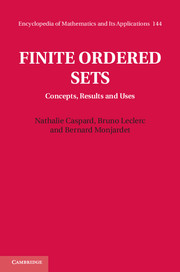Book contents
- Frontmatter
- Contents
- Preface
- 1 Concepts and examples
- 2 Particular classes of ordered sets
- 3 Morphisms of ordered sets
- 4 Chains and antichains
- 5 Ordered sets and distributive lattices
- 6 Order codings and dimensions
- 7 Some uses
- A About algorithmic complexity
- B The 58 types of connected ordered sets of size at most 5
- C The numbers of ordered sets and of types of ordered sets
- D Documentation marks
- References
- List of symbols
- Index
Preface
Published online by Cambridge University Press: 05 February 2012
- Frontmatter
- Contents
- Preface
- 1 Concepts and examples
- 2 Particular classes of ordered sets
- 3 Morphisms of ordered sets
- 4 Chains and antichains
- 5 Ordered sets and distributive lattices
- 6 Order codings and dimensions
- 7 Some uses
- A About algorithmic complexity
- B The 58 types of connected ordered sets of size at most 5
- C The numbers of ordered sets and of types of ordered sets
- D Documentation marks
- References
- List of symbols
- Index
Summary
The notions of order, classification, and ranking exist in numerous human activities and situations: administrative or social hierarchies, organization charts, scheduling of sports tournaments, precedence, succession or preference orders, agendas, school, audiovisual or webpage rankings, alphabetical and lexicographic orders, etc. It would be endless to enumerate all the situations where orders appear.
It is thus not surprising, considering the development of the use of mathematics in the modeling of multiple phenomena, to find a great number of fields where order mathematics occur. Nevertheless, the latter are relatively recent. Of course, in mathematics, the notion of the order of magnitude has been known for a long time and in the sixteenth century the symbols “<” and “>” appeared for the first time to express “less than” and “greater than.” Yet, the abstract notion of an order defined as a particular type of transitive relation was developed only between 1880 and 1914 by mathematicians and/or logicians such as Peirce, Peano, Schröder, Cantor, Dedekind, Russell, Huntington, Scheffer, and Hausdorff, in the context of the formalization of the “algebra of logic” (that is, Boolean algebra) and also of the creation of set theory (with the study of “order types”). Lattices, which are particular orders since they can be defined algebraically, were also considered as early as the later part of the nineteenth century by Schröder and Dedekind, and then fell into oblivion before arising again during the 1930s thanks to Birkhoff, Öre, and several other eminent mathematicians.
- Type
- Chapter
- Information
- Finite Ordered SetsConcepts, Results and Uses, pp. vii - xiiPublisher: Cambridge University PressPrint publication year: 2012



